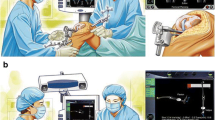Abstract
The successful outcome of total knee arthroplasty (TKA) is very much dependent on precise positioning of the components. Inaccuracy may result in complaints as well as in early mechanical failure. Between March 2003 and September 2005, 69 TKA procedures were performed by the computer navigated technique. The postoperative outcome of this cohort was compared with the same number of TKAs done by the traditional technique. The lower limb anatomical axis was determined in all cases pre- and postoperatively by weight-bearing anteroposterior (AP) and lateral full length X-rays. The positions of femoral and tibial components were recorded. Comparing the data in the navigation group on the AP view, 96.6% of femoral and 96.9% of tibial components and on the lateral view in 95.4% of femoral and in 95.4% of tibial components, the overall postoperative axis in 95.4% fell in the range considered in the literature as optimal. In the traditional group on the AP view, 75.7% of femoral and 68.1% of tibial components and on the lateral view 81.8% of femoral and 63.6% of tibial components, the overall postoperative axis in 60.6% fell between the values considered optimal in the literature. It seems to be proven that the computer navigated total knee arthroplasty technique ensures positioning of components significantly more precisely compared with the traditional surgical method. Accuracy of navigation depends on the software used, on the correct detection of anatomical reference points, and on a potentially uneven thickness of the cement layer during final insertion of the components. The computer navigated technique does not substitute professional skill and experience, since it merely transmits information for the surgeon. The decision is in the hands of the doctor during the entire procedure. The real benefits of the computer navigated technique require further research and can be determined only after long-term analyses.
Résumé
Le succés de l’arthroplastie totale de genou dépend beaucoup du positionnement des implants. Entre mars 2003 et septembre 2005, 69 athroplasties étaient réalisées avec une technique de navigation informatique. Le devenir de ce groupe était comparé avec le même nombre d’arthroplasties faites avec la technique traditionnelle. L’axe anatomique du membre inférieur était déterminé par des radiographies antéro-postérieures en charge et de profil en extension. Dans le groupe navigué, la position des implants était optimale sur les radio de face pour 96,6% des pièces fémorales, 96,9% des pièces tibiales, sur les radio de profil pour 95,4% des pièces fémorales et tibiales, avec un bon axe dans 95,4% des cas. Dans le groupe traditionnel, les chiffres étaient: 75,7% pour les pièces fémorales, 68,1% pour les pièces tibiales sur les radio de face et 81,8% pour les pièces fémorales, 63,6% pour les pièces tibiales sur les radio de profil avec un bon axe dans 60,6% des cas. Il semble prouvé que l’utilisation de la navigation informatique permette un meilleur positionnement des implants que la méthode conventionnelle. L’efficacité de la navigation dépend du logiciel utilisé, de la précision du repérage anatomique et éventuellement de l’épaisseur de la couche de ciment lors de l’implantation définitive. Cette technique ne remplace pas l’expérience du chirurgien mais transmet des informations fiables, les décisions restant entre les mains de l’opérateur pendant toute l’intervention. Le bénéfice réel sera établi après des études à long terme.




Similar content being viewed by others
References
Amiot LP, Poulin F (2004) Computed tomography-based navigation for hip, knee, and spine surgery. Clin Orthop 421:77–86
Archibeck MJ, White RE Jr (2004) What’s new in adult reconstructive knee surgery. J Bone Joint Surg Am 86-A:1839–1849
Chauhan SK, Scott RG, Breidahl W, Beaver RJ (2004) Computer-assisted knee arthroplasty versus a conventional jig-based technique. A randomised, prospective trial. J Bone Joint Surg Br 86-B:372–377
Delp SL, Stulberg DS, Davies B, Picard F, Leitner F (1998) Computer assisted knee replacement. Clin Orthop 354:49–56
Engh GA (2003) The difficult knee: severe varus and valgus. Clin Orthop 416:58–63
Foran J, Mont MA, Etienne G, Jones LC, Hungerford DS (2004) The outcome of total arthroplasty in obese patients. J Bone Joint Surg Am 86-A:1609–1615
Jenny JY, Boeri C (2003) Total knee prosthesis implantation with a non-image-based navigation system: rationale, technique, case-control comparative study with a conventional instrumented implantation. Tech Orthop 18:160–166
Nizard R (2002) Computer assisted surgery for total knee arthroplasty. Acta Orthop Belg 68:215–230
Porter ML, Gambhir AK, Pradhan N (2004) Image-guided surgery for total knee replacement. J Bone Joint Surg Am 86-A:1096
Sparmann M, Wolke B, Czupalla H, Banzer D, Zink A (2003) Positioning of total knee arthroplasty with and without navigation support. A prospective, randomised study. J Bone Joint Surg Br 86-B:830–835
Stöckl B, Nofler M, Rosiek R, Fischer M, Krismer M, Kessler O (2004) Navigation improves accuracy of rotational alignment in total knee arthroplasty. Clin Orthop 426:180–186
Stulberg DS, Loan PB, Sarin V (2002) Computer-assisted navigation in total knee replacement: results of an initial experience in thirty-five patients. J Bone Joint Surg Am 84-A(Suppl 2):S90–S98
Stulberg DS (2003) How accurate is current TKR instrumentation? Clin Orthop 416:177–184
Tria AJ Jr, Coon TM (2003) Minimal incision total knee arthroplasty: early experience. Clin Orthop 416:185–190
Victor J, Hoste D (2004) Image-based computer-assisted total knee arthroplasty leads to lower variability in coronal alignment. Clin Orthop 428:131–139
Author information
Authors and Affiliations
Corresponding author
Rights and permissions
About this article
Cite this article
Bejek, Z., Sólyom, L. & Szendrõi, M. Experiences with computer navigated total knee arthroplasty. International Orthopaedics (SICO 31, 617–622 (2007). https://doi.org/10.1007/s00264-006-0254-0
Received:
Revised:
Accepted:
Published:
Issue Date:
DOI: https://doi.org/10.1007/s00264-006-0254-0




